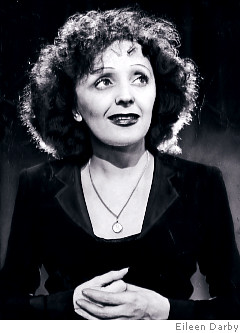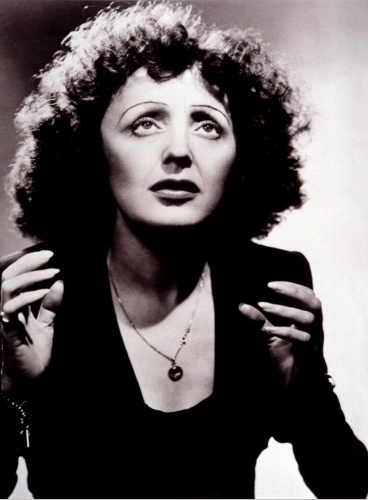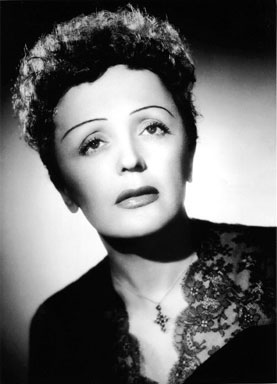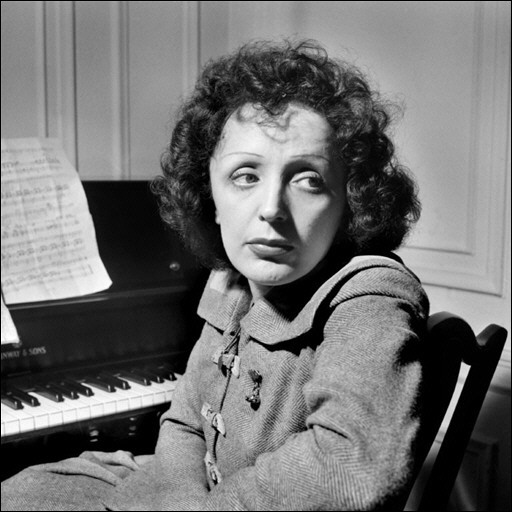<Back to Index>
- Geneticist Cyril Dean Darlington, 1903
- Singer Édith Giovanna Gassion (Piaf), 1915
- King of Spain Felipe V, 1683
PAGE SPONSOR



Édith Piaf (19 December 1915 – 11 October 1963), born Édith Giovanna Gassion, was a French singer and cultural icon who became universally regarded as France's greatest popular singer. Her singing reflected her life, with her specialty being ballads. Among her songs are "La Vie en rose" (1946), "Non, je ne regrette rien" (1960), "Hymne à l'amour" (1949), "Milord" (1959), "La Foule" (1957), "l'Accordéoniste" (1955), and "Padam... Padam..." (1951).
Despite numerous biographies, much of Piaf's life is shrouded in mystery. She was born Édith Giovanna Gassion in Belleville, Paris, a high - immigration district. Legend has it that she was born on the pavement of Rue de Belleville 72, but her birth certificate cites the Hôpital Tenon, the hospital for the 20th arrondissement of which Belleville is part. She was named Édith after the World War I British nurse Edith Cavell, who was executed for helping French soldiers escape from German captivity. Piaf — a Francilien colloquialism for "sparrow" — was a nickname she would receive 20 years later. Her mother, Annetta Giovanna Maillard (1895 – 1945), was of French descent on her father's side and of Italian and Berber origin on her mother's. She was a native of Livorno, a port city on the western edge of Tuscany, Italy. She worked as a café singer under the name Line Marsa. Louis - Alphonse Gassion (1881 – 1944), Édith's father, was a Norman street acrobat with a past in the theatre. Édith's parents soon abandoned her, and she lived for a short time with her maternal grandmother, Emma (Aïcha) Saïd ben Mohammed (1876 – 1930). Before he enlisted with the French Army in 1916 to fight in World War I, her father took her to his mother, who ran a brothel in Normandy. There, prostitutes helped look after Piaf. From the age of three to seven, Piaf was allegedly blind as a result of keratitis. According to one of her biographies, she recovered her sight after her grandmother's prostitutes pooled money to send her on a pilgrimage honoring Sainte Thérèse de Lisieux, which the author claims resulted in a miraculous healing.
In 1929, at 14, she joined her father in his acrobatic street performances all over France, where she first sang in public. She took a room at Grand Hôtel de Clermont (18 rue Veron, Paris 18ème) and separated from him, going her own way as a street singer in Pigalle, Ménilmontant, and the Paris suburbs (cf. the song "Elle fréquentait la Rue Pigalle"). She joined her friend Simone Berteaut ("Mômone") in this endeavor, and the two became lifelong partners in mischief. She was about 16 when she fell in love with Louis Dupont, a delivery boy. At 17, she had her only child, a girl named Marcelle, who died of meningitis at age two. Like her mother, Piaf found it difficult to care for a child while living a life of the streets, so she often left Marcelle behind while she was away, and Dupont raised her until her death.
In 1935 Piaf was discovered in the Pigalle area of Paris by nightclub owner Louis Leplée, whose club Le Gerny off the Champs - Élysées was frequented by the upper and lower classes alike. He persuaded her to sing despite her extreme nervousness, which, combined with her height of only 142 centimetres (4 ft 8 in), inspired him to give her the nickname that would stay with her for the rest of her life and serve as her stage name, La Môme Piaf (Parigot translatable as "The Waif Sparrow", "The Little Sparrow", or "Kid Sparrow"). Leplée taught her the basics of stage presence and told her to wear a black dress, later to become her trademark apparel.Leplée ran an intense publicity campaign leading up to her opening night, attracting the presence of many celebrities, including actor Maurice Chevalier. Her nightclub gigs led to her first two records produced that same year, with one of them penned by Marguerite Monnot, a collaborator throughout Piaf's life.
On 6 April 1936, Leplée was murdered and Piaf was questioned and accused as an accessory, but was acquitted. Leplée had been killed by mobsters with previous ties to Piaf. A barrage of negative media attention now threatened her career. To rehabilitate her image, she recruited Raymond Asso, with whom she would become romantically involved. He changed her stage name to "Édith Piaf", barred undesirable acquaintances from seeing her, and commissioned Monnot to write songs that reflected or alluded to Piaf's previous life on the streets.
In 1940, Édith co-starred in Jean Cocteau's successful one-act play Le Bel Indifférent. She began forming friendships with prominent people, including Chevalier and poet Jacques Borgeat. She wrote the lyrics of many of her songs and collaborated with composers on the tunes. In 1944, she discovered Yves Montand in Paris, made him part of her act, and became his mentor and lover. Within a year, he became one of the most famous singers in France, and she broke off their relationship when he had become almost as popular as she was.
During this time she was in great demand and very successful in Paris as France's most popular entertainer. After the war, she became known internationally, touring Europe, the United States, and South America. In Paris, she gave Atahualpa Yupanqui (Héctor Roberto Chavero) — the most important Argentine musician of folklore — the opportunity to share the scene, making his debut in July 1950. She helped launch the career of Charles Aznavour in the early 1950s, taking him on tour with her in France and the United States and recording some of his songs. At first she met with little success with U.S. audiences, who regarded her as downcast. After a glowing review by a prominent New York critic, however, her popularity grew, to the point where she eventually appeared on The Ed Sullivan Show eight times and at Carnegie Hall twice (1956 and 1957).
Édith Piaf's signature song "La vie en rose" was written in 1945 and was voted a Grammy Hall of Fame Award in 1998.
Bruno Coquatrix's famous Paris Olympia music hall is where Piaf achieved lasting fame, giving several series of concerts at the hall, the most famous venue in Paris, between January 1955 and October 1962. Excerpts from five of these concerts (1955, 1956, 1958, 1961, 1962) were issued on record and CD and have never been out of print. The 1961 concerts were promised by Piaf in an effort to save the venue from bankruptcy and where she debuted her song "Non, je ne regrette rien". In April 1963, Piaf recorded her last song, "L'homme de Berlin".
During World War II, she was a frequent performer at German Forces social gatherings in occupied France, and many considered her a traitor; following the war she stated that she had been working for the French Resistance. While there is no evidence of this, it does seem to be true that she was instrumental in helping a number of individuals (including at least one Jew) escape Nazi persecution. Throughout it all, she remained a national and international favorite. Piaf dated a Jewish pianist during this time and co-wrote a subtle protest song with Monnot. According to one story, singing for high-ranking Germans at the One Two Two Club earned Piaf the right to pose for photographs with French prisoners of war, to boost their morale. The Frenchmen were supposedly able to cut out their photos and use them as forged passport photos.
The love of Piaf's life, the married boxer Marcel Cerdan, died in a plane crash in October 1949, while flying from Paris to New York City to meet her. Cerdan's Air France flight, flown on a Lockheed Constellation, went down in the Azores, killing everyone on board, including noted violinist Ginette Neveu. Piaf and Cerdan's affair made international headlines, as Cerdan was the former middleweight champion of the world and a legend in France in his own right.
In 1951, Piaf was seriously injured in a car crash along with Charles Aznavour, breaking her arm and two ribs, and thereafter had serious difficulties arising from morphine and alcohol addictions. Two more near fatal car crashes exacerbated the situation. Jacques Pills, a singer, took her into rehabilitation on three different occasions to no avail.
Piaf married Jacques Pills in 1952 (her matron of honour was Marlene Dietrich) and divorced him in 1956. In 1962, she wed Théo Sarapo (Theophanis Lamboukas), a Greek hairdresser - turned - singer and actor who was 20 years her junior. The couple sang together in some of her last engagements.
Piaf died of liver cancer aged 47 at Plascassier, on the French Riviera, on 11 October 1963 (according to some, 10 October in Paris). She had been drifting in and out of consciousness for several months. It is said that Sarapo drove her body back to Paris secretly so that fans would think she had died in her hometown. She is buried in Père Lachaise Cemetery in Paris next to her daughter Marcelle, where her grave is among the most visited.
Although she was denied a funeral mass by the Roman Catholic archbishop of Paris because of her lifestyle, her funeral procession drew tens of thousands of mourners onto the streets of Paris and the ceremony at the cemetery was attended by more than 100,000 fans. Charles Aznavour recalled that Piaf's funeral procession was the only time since the end of World War II that he saw Parisian traffic come to a complete stop.
In Paris, a two-room museum is dedicated to her, the Musée Édith Piaf (5 rue Crespin du Gast). "Piaf... Her
Story... Her Songs" (2003) is a film starring Raquel Bitton in her
performance tribute to Edith Piaf. Bitton performs Piaf's most famous
songs and describes her tempestuous life. Woven into the filmed concert
is a luncheon in Paris, hosted by Bitton, in which some of Piaf's
composers, friends, lovers, and family share their memories. These
include Michel Rivgauche and Francis Lai, two of Piaf's composers, as
well as Marcel Cerdan, Jr., son of the boxing champion who was her
greatest love. La Vie en rose, a film about her life directed by Olivier Dahan, debuted at the Berlin Film Festival in February 2007. Titled La Môme in France, the film stars Marion Cotillard in the role that won her the Academy Award for Best Actress (Oscar), as Piaf. Dahan's film follows Piaf's life from early childhood to her death in 1963. David Bret's 1988 biography, Piaf, A Passionate Life, was re-released by JR Books to coincide with the film's release. Piaf's relationship with Cerdan was also depicted in film by Claude Lelouch in the movie Édith et Marcel (1983), with Marcel Cerdan Jr. in the role of his father and Évelyne Bouix portraying Piaf. The film Piaf (1974) depicted her early years, and starred Brigitte Ariel, with early Piaf songs performed by Betty Mars. In the 1973 Soviet film Seventeen Moments of Spring, her song "Non, je ne regrette rien" is listened to by Stirlitz and Pastor Schlag during their trip in a car together, which took place in the time of the World War II, which of-course was impossible since the song was written in 1956. In 1996, Ari Folman released the near futuristic comedy Saint Clara.
In this film, Édith Piaf is repeatedly mentioned by many of the
adults, who remember her seemingly from school, and prove that they are
part of the leading culture, as opposed to the immigrants, but the
children on both sides have no knowledge of her, and ask who she was.
The movie ends with the local men discovering that the Russian
immigrants were intimately familiar with Piaf. In the film Inception (2010), her song "Non, je ne regrette rien"
is used frequently to signal to the characters that they are about to
be ejected from the dream. The same song played several times slower
than the original is also one the film's main musical themes. The film also stars Marion Cotillard, who had portrayed Piaf in La Vie En Rose. In her song "Slave to the Rhythm" (1985 extended version), Grace Jones begins
with an introductory narration that quotes Édith Piaf: "This is
what Édith Piaf used to say, use your faults, use your defects,
then you're going to be a star...". In the film Saving Private Ryan, Piaf's 1943 songs "C'Était Une Histoire D'Amour" and "Tu Es Partout" are central to providing a common thread of longing for loves and lives left behind in scenes between Captain Miller (Tom Hanks) and Private Ryan (Matt Damon) as well as providing a context for anecdotes from other central characters.
The minor planet of 3772 Piaf, discovered by Soviet astronomer Lyudmila Karachkina in 1982, is named after her.

